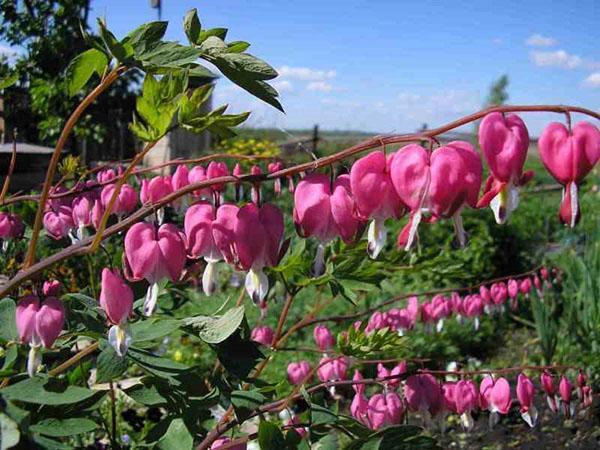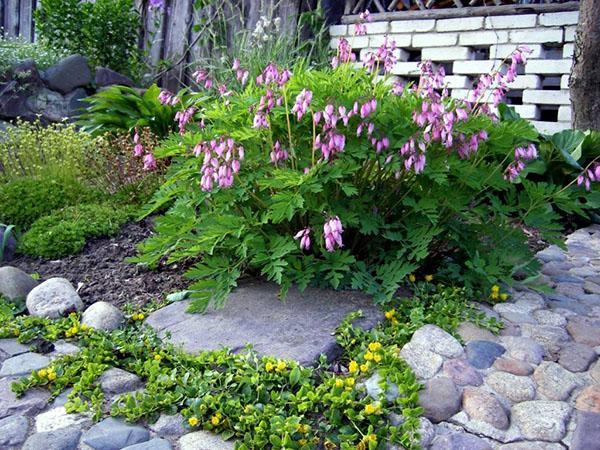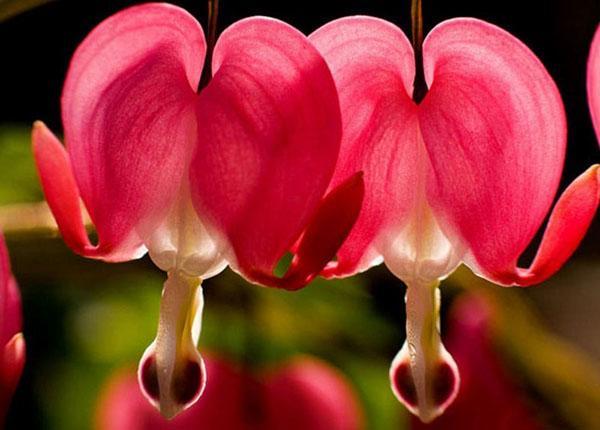An excellent find for flower growers - types of dicentra
 A few decades ago, summer cottages were decorated with various types of dicentra grown by fans of sophisticated flowers. Interest in the plant, in our time, is caused by its delicate buds, reminiscent of small hearts. Even with a barely noticeable breath of wind, they sway exquisitely, attracting the attention of passers-by. If you carefully examine the photo of the dicenter, you can notice its unique beauty and understand why the flower is called "Broken Heart".
A few decades ago, summer cottages were decorated with various types of dicentra grown by fans of sophisticated flowers. Interest in the plant, in our time, is caused by its delicate buds, reminiscent of small hearts. Even with a barely noticeable breath of wind, they sway exquisitely, attracting the attention of passers-by. If you carefully examine the photo of the dicenter, you can notice its unique beauty and understand why the flower is called "Broken Heart".
An old legend tells of the unhappy love of a lovely girl Jeanette. Once she got lost in a dense forest and got into trouble. A brave young man came to her aid, whom she fell in love with. Since then, the girl sought a meeting with him. And when I saw him with another woman, my heart was torn to pieces. Jeanette died, but in memory of her unhappy love, a flower grew, the buds of which resemble a broken heart. Of course, the story is very sad. However, many types of dicenter give their fans pleasant moments of pleasure.
The flower belongs to the Dymyankovye family. In its natural environment, it is found in China, the Far East and North America.
General description of the plant

- pink;
- carmine;
- cream;
- white;
- purple;
- red;
- yellow.
 The size of each bud is about 2 cm, but, lined up on an arched shoot by the "company", they look very attractive. The buds collected in drooping brush, exquisitely rise above the greenery. The lower part is slightly open and decorated with a snow-white "drop" of delicate petals.
The size of each bud is about 2 cm, but, lined up on an arched shoot by the "company", they look very attractive. The buds collected in drooping brush, exquisitely rise above the greenery. The lower part is slightly open and decorated with a snow-white "drop" of delicate petals.
 Some varieties of dicentra are capable of growing up to a meter in height, although there are those that reach only 30 cm. The leaf plates of the flower resemble delicate green lace with a subtle bluish tint. Even when the plant does not bloom, it itself is admirable due to the decorative foliage.
Some varieties of dicentra are capable of growing up to a meter in height, although there are those that reach only 30 cm. The leaf plates of the flower resemble delicate green lace with a subtle bluish tint. Even when the plant does not bloom, it itself is admirable due to the decorative foliage.
After flowering, black seed pods are formed on the shoots. If they are collected on time, then the seeds remain viable for 2 years.
Dicenter types are a great gift from nature
 The beauty of wild plants has captivated the hearts of caring people for thousands of years. Each of them has a predisposition for selection, which is why so many different types of plants have appeared in our gardens. This also applies to the dicenter. Today biologists have more than 20 varieties of this pretty garden flower. As a result, the plant can delight people with its buds in early spring, summer and even mid-autumn. A truly magnificent plant! Consider several popular varieties.
The beauty of wild plants has captivated the hearts of caring people for thousands of years. Each of them has a predisposition for selection, which is why so many different types of plants have appeared in our gardens. This also applies to the dicenter. Today biologists have more than 20 varieties of this pretty garden flower. As a result, the plant can delight people with its buds in early spring, summer and even mid-autumn. A truly magnificent plant! Consider several popular varieties.
The flower was described in 1735 by the famous botanist Carl Linnaeus. It was brought to Europe from Japan in 1816.
Beautiful
 The magnificent guest from North America, "Dicentra formosa" was cultivated for decorative purposes in the early 19th century. This perennial plant grows up to 30 or 40 cm in height. Elastic shoots are decorated with green foliage on long petioles. In some varieties, it comes with a delicate silvery shade.Inflorescences appear in the summer months and are painted in the following colors:
The magnificent guest from North America, "Dicentra formosa" was cultivated for decorative purposes in the early 19th century. This perennial plant grows up to 30 or 40 cm in height. Elastic shoots are decorated with green foliage on long petioles. In some varieties, it comes with a delicate silvery shade.Inflorescences appear in the summer months and are painted in the following colors:
- cream;
- pink;
- red;
- white.
 Luxurious buds of beautiful dicentra immediately catch the eye, as they are collected in racemose inflorescences. From a distance, they resemble a lush bouquet of bright flowers. The plant tolerates cold winters wonderfully, despite its sophisticated appearance. There are several subspecies of this luxurious flower.
Luxurious buds of beautiful dicentra immediately catch the eye, as they are collected in racemose inflorescences. From a distance, they resemble a lush bouquet of bright flowers. The plant tolerates cold winters wonderfully, despite its sophisticated appearance. There are several subspecies of this luxurious flower.
Aurora
 The plant grows up to 35 cm in height and can bloom in one area for up to 8 years. Thanks to this, with the help of the beautiful dicenter - Aurora, gardeners form unique landscapes of the dacha territory. Outwardly, it resembles a lush grassy bush with delicate grayish-green pinnately dissected leaves. The buds are heart-shaped and painted white. Feels great in semi-shaded areas of the garden and in sunny places. Winter hardy. In severe frosts (below 30 ° C), the white dicentra needs additional shelter.
The plant grows up to 35 cm in height and can bloom in one area for up to 8 years. Thanks to this, with the help of the beautiful dicenter - Aurora, gardeners form unique landscapes of the dacha territory. Outwardly, it resembles a lush grassy bush with delicate grayish-green pinnately dissected leaves. The buds are heart-shaped and painted white. Feels great in semi-shaded areas of the garden and in sunny places. Winter hardy. In severe frosts (below 30 ° C), the white dicentra needs additional shelter.
Thanks to the fleshy rhizome, which penetrates deep into the soil in search of moisture, the plant does not need to be watered. Accordingly, the wetlands are not suitable for growing such a dicenter.
Bakchanal (Bekkanal)
 A charming herbaceous perennial grows up to 80 cm in height. He is able to delight his fans for a whole season. The dicentra beautiful Bakchanal wonderfully takes root both in open areas and in partial shade. In addition, it perfectly tolerates frost in winter.
A charming herbaceous perennial grows up to 80 cm in height. He is able to delight his fans for a whole season. The dicentra beautiful Bakchanal wonderfully takes root both in open areas and in partial shade. In addition, it perfectly tolerates frost in winter.

The flower buds resemble a heart pierced by an arrow, indicating the legend of the plant's name. Someone sees them as stylish medallions that hang on flexible peduncles against the background of rich greenery. Dicentra Bekkanal (as it is sometimes called) is distinguished by inflorescences of dark red or purple color. The lower tip of the bud is decorated with a white border. Some hybrid varieties only grow up to 20 cm and are considered dwarf varieties. They also have blue-green carved leaf plates. The "hearts" of the buds are flattened. Size - about 2 cm in diameter. One flowering period lasts approximately 15 days.
Laksharient
 The perennial undersized beauty attracts true fans of flowering plants. It grows to about 35 cm. It is compact and beautifully shaped. The dicentra beautiful Laksharient gives an abundance of exquisite buds from early May to mid-September. Its openwork carved leaf plates are located near the soil in the root area. They are painted silver-green. Long brushes, decorated with heart-shaped buds, appear on thin tall shoots. Most often they are purple-pink in color. Ornamental shrub perfectly tolerates shaded areas of the garden.
The perennial undersized beauty attracts true fans of flowering plants. It grows to about 35 cm. It is compact and beautifully shaped. The dicentra beautiful Laksharient gives an abundance of exquisite buds from early May to mid-September. Its openwork carved leaf plates are located near the soil in the root area. They are painted silver-green. Long brushes, decorated with heart-shaped buds, appear on thin tall shoots. Most often they are purple-pink in color. Ornamental shrub perfectly tolerates shaded areas of the garden.
King of Hearts
 Although this popular subspecies grows up to 25 cm, it successfully takes root both in open areas and in the shade. Heart-shaped buds of the King of Hearts dicentra are colored pink or purple. They appear on the bush at the end of May and are pleasing to the eye until September. The leaf plates, which form the basal rosette, are painted in two colors: the upper part is green, the back is bluish. The plant feels great in a flower bed for 6 years. After that, he needs a transplant. The flower is used for mixed country flower beds, alpine slides and as single bushes at the curbs.
Although this popular subspecies grows up to 25 cm, it successfully takes root both in open areas and in the shade. Heart-shaped buds of the King of Hearts dicentra are colored pink or purple. They appear on the bush at the end of May and are pleasing to the eye until September. The leaf plates, which form the basal rosette, are painted in two colors: the upper part is green, the back is bluish. The plant feels great in a flower bed for 6 years. After that, he needs a transplant. The flower is used for mixed country flower beds, alpine slides and as single bushes at the curbs.
Gorgeous
 An amazingly cute look of this flower in its natural environment is found in China. In Europe, it began to be used for cultivation in flower beds and gardens in the early 19th century. Since it grows up to 100 cm, it is considered a tall garden decoration. The species tolerates frost wonderfully, although sometimes it needs additional shelter. There are several varieties of this slender giant.
An amazingly cute look of this flower in its natural environment is found in China. In Europe, it began to be used for cultivation in flower beds and gardens in the early 19th century. Since it grows up to 100 cm, it is considered a tall garden decoration. The species tolerates frost wonderfully, although sometimes it needs additional shelter. There are several varieties of this slender giant.
Alba
 Surprisingly attractive dicenter, magnificent Alba has long won the hearts of color lovers. It does not require special care, but it pleases with abundant flowering, which lasts more than a month.The bushes grow up to 100 cm, so the flower beds look original against the background of other plants.
Surprisingly attractive dicenter, magnificent Alba has long won the hearts of color lovers. It does not require special care, but it pleases with abundant flowering, which lasts more than a month.The bushes grow up to 100 cm, so the flower beds look original against the background of other plants.
 Such a gorgeous white dicentra is distinguished by graceful buds. It is not only the color that is striking, but also the shape. In addition, its flowers retain their freshness for a long time when cut.
Such a gorgeous white dicentra is distinguished by graceful buds. It is not only the color that is striking, but also the shape. In addition, its flowers retain their freshness for a long time when cut.
To stimulate flowering, the plant is planted in fertile land, which is regularly fed. In autumn, all shoots are cut off, leaving 5 cm, and then covered with spruce branches.
Dicentra Spectabilis
 The plant is distinguished by many high (about 60 cm) shoots, on which huge leaves grow. They have a dissected character, which is harmoniously combined with amazing clusters of buds gracefully hanging from flexible peduncles. The gorgeous pink dicentra is a wonderful decoration for a summer cottage. Her cute "flashlights" leave no one indifferent. Delicate, pink inflorescences with snow-white tips, amazingly sway with a light breath of breeze. Therefore, the plant immediately appears on the territory of country houses. In addition, "Dicentra Spectabilis" blooms profusely for several months, bringing people joy and satisfaction.
The plant is distinguished by many high (about 60 cm) shoots, on which huge leaves grow. They have a dissected character, which is harmoniously combined with amazing clusters of buds gracefully hanging from flexible peduncles. The gorgeous pink dicentra is a wonderful decoration for a summer cottage. Her cute "flashlights" leave no one indifferent. Delicate, pink inflorescences with snow-white tips, amazingly sway with a light breath of breeze. Therefore, the plant immediately appears on the territory of country houses. In addition, "Dicentra Spectabilis" blooms profusely for several months, bringing people joy and satisfaction.
Dicentra Eximia
 The flower was brought to Europe from the North American continent in the last century. It grows wonderfully in flower beds in the company of local flowers. The peculiarity of "Dicentra Eximia" is that the plant has thickened long shoots without leaves. They decorate only the root rosette of the flower. The buds are located on arched peduncles and are collected in graceful brushes. Abundant flowering occurs in late spring and continues until early autumn. The exceptional "Eximia" variety is considered frost-resistant. In colder latitudes, the plant is covered with spruce branches or peat.
The flower was brought to Europe from the North American continent in the last century. It grows wonderfully in flower beds in the company of local flowers. The peculiarity of "Dicentra Eximia" is that the plant has thickened long shoots without leaves. They decorate only the root rosette of the flower. The buds are located on arched peduncles and are collected in graceful brushes. Abundant flowering occurs in late spring and continues until early autumn. The exceptional "Eximia" variety is considered frost-resistant. In colder latitudes, the plant is covered with spruce branches or peat.
Graceful
 The original bushes of this plant are planted along curbs or dividing fences. Its tall foliage is located in the root zone. Therefore, the flower resembles a fern. Dicenter graceful pleases its fans with amazing pink buds, which are collected in voluminous bouquets. The flowering period lasts the whole summer. Who would refuse such beauty? Only indifferent people.
The original bushes of this plant are planted along curbs or dividing fences. Its tall foliage is located in the root zone. Therefore, the flower resembles a fern. Dicenter graceful pleases its fans with amazing pink buds, which are collected in voluminous bouquets. The flowering period lasts the whole summer. Who would refuse such beauty? Only indifferent people.
Golden tears
 A gorgeous piece of art from the universe - the Golden Tears dicenter. An adult plant can reach a height of more than 2 m. Flexible, but strong shoots are strewn with many leaves of an oval slightly elongated shape. During the flowering period, the bush puts on a blanket of bright yellow "broken hearts". All of them are neatly arranged on clusters up to 20 cm long. Magnificent bouquets appear on the plant for at least 2 years after planting.
A gorgeous piece of art from the universe - the Golden Tears dicenter. An adult plant can reach a height of more than 2 m. Flexible, but strong shoots are strewn with many leaves of an oval slightly elongated shape. During the flowering period, the bush puts on a blanket of bright yellow "broken hearts". All of them are neatly arranged on clusters up to 20 cm long. Magnificent bouquets appear on the plant for at least 2 years after planting.
During the flowering period, the dicenter needs artificial support and tying. This way she will be able to maintain her lush appeal throughout the season.
Golden vine
 This perennial plant resembles a tropical liana from the side. It grows up to 2.5 m and is wonderfully supported on a support made by gardeners. The Golden Vine depicted in the photo of the bleeding center looks very attractive. Its small, light green foliage completely covers the plant. Therefore, bright yellow buds of large sizes look original against their background. The flower-bearing clusters are abundantly covered with unblown buds and flowers from late spring to the first frost. Near the dicenter, gardeners feel amazing tranquility and truly “heavenly delight”.
This perennial plant resembles a tropical liana from the side. It grows up to 2.5 m and is wonderfully supported on a support made by gardeners. The Golden Vine depicted in the photo of the bleeding center looks very attractive. Its small, light green foliage completely covers the plant. Therefore, bright yellow buds of large sizes look original against their background. The flower-bearing clusters are abundantly covered with unblown buds and flowers from late spring to the first frost. Near the dicenter, gardeners feel amazing tranquility and truly “heavenly delight”.